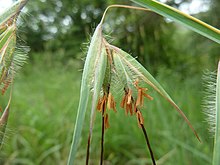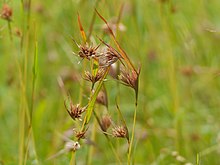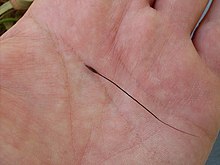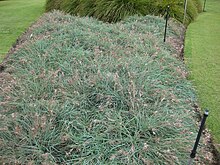Themeda triandra
| Themeda triandra | |
|---|---|

| |
| Scientific classification | |
| Kingdom: | Plantae |
| Clade: | Tracheophytes |
| Clade: | Angiosperms |
| Clade: | Monocots |
| Clade: | Commelinids |
| Order: | Poales |
| Family: | Poaceae |
| Subfamily: | Panicoideae |
| Genus: | Themeda |
| Species: | T. triandra
|
| Binomial name | |
| Themeda triandra Forssk.[1]
| |
| Synonyms[1] | |
|
show
List | |
Themeda triandra is a perennial tussock-forming grass widespread in Africa, Australia, Asia and the Pacific. In Australia it is commonly known as kangaroo grass[2] and in East Africa and South Africa it is known as red grass and red oat grass or as rooigras in Afrikaans. Kangaroo grass was formerly thought to be one of two species, and was named Themeda australis.
The plant has traditional uses as food and medicine in Africa and Australia. Indigenous Australians harvested it to make bread and string for fishing nets around 30,000 years ago. It was used as livestock feed in early colonial Australia, but this use was largely replaced by introduced plants. As of 2021 there is a large government-funded project under way to investigate the possibility of growing kangaroo grass commercially in Australia for use as a regular food source for humans.




Description[]
Themeda triandra is a grass which grows in dense tufts up to 1.5 metres (4 ft 11 in) tall and 0.5 metres (1 ft 8 in) wide. It flowers in summer, producing large red-brown spikelets on branched stems.[3] The leaves are 10–30 centimetres (3.9–11.8 in) in length and 1–8 millimetres (0.039–0.315 in) wide[4] but can exceed 10–50 centimetres (3.9–19.7 in) long and 2–5 millimetres (0.079–0.197 in) wide.[3] Its inflorescence is compounded, fasciculated, is 10–30 centimetres (3.9–11.8 in) long and composed of a single raceme. It pedicels are oblong and are 0.5 mm long while its lemma is 25–70 millimetres (0.98–2.76 in) long and is both apical and geniculate. The column of lemma's awn is hispidulous and twisted.[4]
Its leaves are a grey-green colour in winter, turning red-brown in summer. The blooms exuding a strong perfume.[5]
Taxonomy and naming[]
Themeda triandra was first formally described in 1775 by Peter Forsskål who published the description in Flora Aegyptiaco-Arabica.[6] There are many synonyms of this species.[7] The specific epithet (triandra) is the feminine of the Botanical Latin adjective triandrus, meaning "with three stamens",[8] based on the Greek-derived combining forms tri-, three, and -andrus, male.[9]
Kangaroo grass was formerly thought to be one of two species, and was named Themeda australis.[5]
Distribution and habitat[]
Themeda triandra is found across Asia, Africa, Australia, and the Pacific. In Australia, it is found in all of the states and territories.[3] It grows predominantly in grassland and open woodland communities. It is a significant species in temperate grasslands in Australia, a habitat considered to be endangered or threatened in various parts of the country.[3] It does not do well under heavy grazing pressure, but benefits from occasional fire.[10]
It tolerates sandy or clay soils, is drought-tolerant, and can grow in full sun to partial shade.[5]
Uses[]
The young growth is palatable to livestock.[11][12] It serves as a food source for several avian species, including the long-tailed widowbird, and is occasionally used as an ornamental plant.[3]
Traditionally, in Uganda, the hollow stems of the grass are used as a thatch in hut construction, and for creating pulp for paper.[5] T. triandra seed has also been used as a famine food in Africa.[13] In West Africa, the root are used in the creation of a medicine used to treat dysmenorrhoea (painful periods).[14]
In Australia, it is sometimes used as an ornamental plant in rockeries, as a substitute for a lawn, and in cooking. It has also been found to be useful in treating horses for obesity, insulin resistance, and foot inflammation, because it is lower in carbohydrates such as sugar, starch, and fructans than introduced grasses.[5]
Before the colonisation of Australia, kangaroo grass used to be harvested by Aboriginal Australians, who used the leaves and stems for making string, the basis for fishing nets, as well as for food. The grains were harvested and ground into flour and porridge; the flour was used to make a traditional bread (later referred to as damper, although that term is mostly used for the bread made by non-Indigenous Australians), said to have a nutty flavour. Evidence has been found of this food production occurring around 30,000 years ago, with the grain considered to be a staple food and especially valuable in arid areas.[5]
However, in recent years kangaroo grass has been looked upon as a weed which is sometimes eaten by livestock. As of 2021, a four-year research project[15] supported by the Australian Government[16] is being undertaken by a researcher at La Trobe University in collaboration with the Dja Dja Wurrung Aboriginal Clans Corporation of central Victoria, investigating the possibility of developing it as a food crop. It is hoped that kangaroo grass would be able to be grown on a commercial scale and become a regular food source. They have found tussocks of the grass estimated to be over 50 years old, an possibly unique among Australian grasses. The plant has several advantages over currently farmed grains:[15]
- it can survive on land depleted by farming;
- it is very drought-resistant;
- it tolerates extreme changes in temperature;
- it is a perennial grass;
- it can help to restore already degraded grasslands;
- contains 40 per cent more protein than traditional grains used for making bread; and
- because of the way it grows, forming a very dense tussock with its leaves bending outwards, it protects the soil and creates its own little ecosystem – it conserves moisture, creating habitat for small animals such as native insects and invertebrates.
The project will draw heavily on the knowledge of the traditional owners of the land, and there will be ongoing communication with farmers and Landcare Australia groups.[16]
The project follows a smaller, crowdfunded project undertaken in 2017 by writer Bruce Pascoe on his own property in Gipsy Point, eastern Victoria, managed by volunteers, to develop several Indigenous Australian food crops, including murnong (yam daisy), kangaroo grass and native raspberries.[17]
References[]
- ^ Jump up to: a b "Themeda triandra". Australian Plant Census. Retrieved 2 July 2019.
- ^ "Themeda triandra - Plant Profiles - Queensland Native Seeds". qldnativeseeds.com.au. Retrieved 3 March 2021.
- ^ Jump up to: a b c d e Liles, Jennifer. "Themeda triandra". Australian National Botanic Garden. Retrieved 2 May 2018.
- ^ Jump up to: a b W.D. Clayton; M. Vorontsova; K.T. Harman; H. Williamson. "Themeda triandra". The Board of Trustees, Royal Botanic Gardens. Kew: GrassBase. Retrieved 2 May 2018.
- ^ Jump up to: a b c d e f Fieldhouse, Rachel (28 September 2018). "Feature Plant Friday - Kangaroo Wheat Grass". PlantingSeeds. Retrieved 1 March 2021.
- ^ "Themeda triandra". APNI. Retrieved 4 November 2017.
- ^ "Themeda triandra". World Checklist of Selected Plant Families (WCSP). Royal Botanic Gardens, Kew.
- ^ Stearn, W.T. (2004). Botanical Latin (4th (p/b) ed.). Portland, Oregon: Timber Press. ISBN 978-0-7153-1643-6. p. 516.
- ^ Stearn (2004), p. 368.
- ^ "Themeda triandra (Kangaroo grass)". New South Wales Government Department of Primary Industries. Retrieved 19 January 2020.
- ^ Burbidge, N. T. Australian Grasses. Angus and Robertson Publishers. 1966.
- ^ "Animal Feed Resources Information System". FAO.org.
- ^ "Wild Grains". The National Academies of Sciences Engineering Medicine. Retrieved 12 June 2021.
- ^ "Feature Plant Friday - Kangaroo Wheat Grass". Planting Seeds. Retrieved 12 June 2021.
- ^ Jump up to: a b Lawrence, Sarah (8 February 2021). "Could native crop, kangaroo grass, become a regular ingredient in bread and help farmers regenerate land?". ABC News. Australian Broadcasting Corporation. Retrieved 1 March 2021.
- ^ Jump up to: a b Wheeler, Mike (19 December 2019). "Kangaroo Grass – is it the super crop for animal feed?". Food & Beverage Industry News. Retrieved 1 March 2021.
- ^ Fitzgerald, Bridget (9 January 2017). "Project to harvest and mill kangaroo grass aims to encourage farmers to adopt native Australian crops". ABC News. Australian Broadcasting Corporation. Retrieved 1 March 2021.
External links[]
| Wikimedia Commons has media related to Themeda triandra. |
- Panicoideae
- Grasses of Africa
- Grasses of Asia
- Grasses of South Africa
- Poales of Australia
- Flora of New South Wales
- Flora of the Northern Territory
- Flora of Queensland
- Flora of South Australia
- Flora of Tasmania
- Flora of Victoria (Australia)
- Angiosperms of Western Australia
- Forages
- Taxa named by Peter Forsskål
